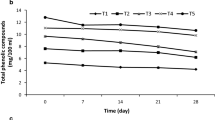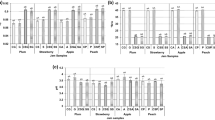Abstract
This study aimed to evaluate the effect of processing steps on bioactive compounds and physicochemical and rheological characteristics of a juçara, banana and strawberry smoothie. The product was obtained by mixing the pulps of these fruits in previously defined proportions. The mixture was standardized in a pilot disintegrator, homogenized at 60 MPa in continuous mode and pasteurized at 90 °C for 35 s. The homogenization step increased the concentration of cyanidin-3-O-glucoside and cyanidin-3-O-rutinoside, major anthocyanins in the smoothie. However, these anthocyanins, as well as perlagonidin-3-O-glucoside, have been reduced (p<0.05) after the pasteurization step. The pasteurization also affected the instrumental color of the smoothie, expressed by Hue angle (p<0.05). Regarding to the rheological behavior, the smoothie, in all processing steps, presented a non-Newtonian fluid behavior with pseudoplastic characteristics (n<1). After homogenization, the smoothie became more fluid and homogeneous. Thus, despite the negative impact of pasteurization on the smoothie’s color, the pasteurized product preserves the bioactive compounds such as flavonoids and phenolic acids that are of great importance to human health. Furthermore, the development of this product contributes to add value to the juçara agro-chain and Atlantic Forest preservation.
Similar content being viewed by others
References
Haminiuk CWI, Maciel GM, Plata-Oviedo MSV, Peralta RM (2012) Phenolic compounds in fruits - an overview. Int J Food Sci Technol 47:2023–2044. https://doi.org/10.1111/j.1365-2621.2012.03067.x
WHO (2003) World Health Organization. Fruit and vegetable promotion initiative – report of the meeting, Geneva.
Saura-Calixto F, Goñi I (2006) Antioxidant capacity of the Spanish Mediterranean diet. Food Chem 94:442–447. https://doi.org/10.1016/j.foodchem.2004.11.033
Naczk M, Shahidi F (2006) Phenolics in cereals, fruits and vegetables: occurrence, extraction and analysis. J Pharm Biomed Anal 41:1523–1542. https://doi.org/10.1016/j.jpba.2006.04.002
Costa AGV, Garcia-Diaz DF, Jimenez P, Silva PI (2013) Bioactive compounds and health benefits of exotic tropical red–black berries. J Funct Foods 5:539–549. https://doi.org/10.1016/j.jff.2013.01.029
Oliveira A, Coelho M, Alexandre EMC et al (2015) Long-term frozen storage and pasteurization effects on strawberry polyphenols content. Food Bioprocess Technol 8:1838–1844. https://doi.org/10.1007/s11947-015-1539-3
Schulz M, da Silva Campelo Borges G, Gonzaga LV, et al (2016) Juçara fruit (Euterpe edulis Mart.): sustainable exploitation of a source of bioactive compounds. Food Res Int 89(Pt 1):14–26. https://doi.org/10.1016/j.foodres.2016.07.027
Bicudo MOP, Ribani RH, Beta T (2014) Anthocyanins, phenolic acids and antioxidant properties of juçara fruits (Euterpe edulis M.) along the on-tree ripening process. Plant Foods Hum Nutr 69:142–147. https://doi.org/10.1007/s11130-014-0406-0
Borges GDSC, Gonzaga LV, Jardini FA et al (2013) Protective effect of Euterpe edulis M. on vero cell culture and antioxidant evaluation based on phenolic composition using HPLC − ESI-MS/MS. Food Res Int 51:363–369. https://doi.org/10.1016/j.foodres.2012.12.035
Inada KOP, Oliveira AA, Revorêdo TB et al (2015) Screening of the chemical composition and occurring antioxidants in jabuticaba (Myrciaria jaboticaba) and jussara (Euterpe edulis) fruits and their fractions. J Funct Foods 17:422–433. https://doi.org/10.1016/j.jff.2015.06.002
Crozier A, Jaganath IB, Clifford MN (2009) Dietary phenolics: chemistry, bioavailability and effects on health. Nat Prod Rep 26:1001–1043. https://doi.org/10.1039/B802662A
Keenan DF, Brunton N, Gormley R, Butler F (2011) Effects of thermal and high hydrostatic pressure processing and storage on the content of polyphenols and some quality attributes of fruit smoothies. J Agric Food Chem 59:601–607. https://doi.org/10.1021/jf1035096
Walkling-Ribeiro M, Noci F, Cronin DA et al (2010) Shelf life and sensory attributes of a fruit smoothie-type beverage processed with moderate heat and pulsed electric fields. LWT - Food Sci Technol 43:1067–1073. https://doi.org/10.1016/j.lwt.2010.02.010
Ribeiro LO, Santos JGC, Gomes FS, et al (2017) Sensory evaluation and antioxidant capacity as quality parameters in the development of a banana, strawberry and juçara smoothie. Food Sci Technol. In Press. https://doi.org/10.1590/1678-457x.12017
Singleton VL, Rossi JA (1965) Colorimetry of total phenolics with phosphomolybdic-phosphotungstic acid reagents. Am J Enol Vitic 16:144–158
Giusti MM, Wrolstad RE (2001) Characterization and measurement of anthocyanins by UV–visible spectroscopy. In: Wrolstad RE, Acree TE, An H, Decker EA et al (eds) Current protocols in food analytical chemistry, 1st edn. John Wiley & Sons, New York, pp F.1.2.1–F1, vol 2, p 13. https://doi.org/10.1002/0471142913.faf0102s00
Santiago MCPA, Gouvêia ACMS, Godoy RLO et al (2014) Analytical standards production for the analysis of pomegranate anthocyanins by HPLC. Brazilian J Food Technol 17:51–57
Pérez-Jiménez J, Arranz S, Tabernero M et al (2008) Updated methodology to determine antioxidant capacity in plant foods, oils and beverages: Extraction, measurement and expression of results. Food Res Int 41:274–285. https://doi.org/10.1016/j.foodres.2007.12.004
Frighetto RTS, Baccan M (2012) Quantification of constitutive phenolic acids of soybean [Glycine max (L.) Merrill] by high performance liquid chromatography (HPLC). Embrapa Environment. http://ainfo.cnptia.embrapa.br/digital/bitstream/item/69603/1/Doc-90-1.pdf. Accessed 16 April 2018
Re R, Pellegrini N, Proteggente A et al (1999) Antioxidant activity applying an improved ABTS radical cation decolorization assay. Free Radic Biol Med 26:1231–1237. https://doi.org/10.1016/S0891-5849(98)00315-3
AOAC (2006) Official methods of analysis. Association of Official Analytical Chemists, Gaithersburg
Ferreira, VLP (1981) Principles and applications of colorimetry in food. ITAL, Campinas
Augusto PED, Ibarz A, Cristianini M (2012) Effect of high pressure homogenization (HPH) on the rheological properties of tomato juice: time-dependent and steady-state shear. J Food Eng 111:570–579. https://doi.org/10.1016/j.jfoodeng.2012.03.015
Karacam CH, Sahin S, Oztop MH (2015) Effect of high pressure homogenization (microfluidization) on the quality of Ottoman strawberry (F. ananassa) juice. LWT - Food Sci Technol 64:932–937. https://doi.org/10.1016/j.lwt.2015.06.064
Sarkis JR, Jaeschke DP, Tessaro IC, Marczak LDF (2013) Effects of ohmic and conventional heating on anthocyanin degradation during the processing of blueberry pulp. LWT - Food Sci Technol 51:79–85. https://doi.org/10.1016/j.lwt.2012.10.024
Rubinskiene M, Viskelis P (2005) Impact of various factors on the composition and stability of black currant anthocyanins. Food Res Int 38:867–871. https://doi.org/10.1016/j.foodres.2005.02.027
Patras A, Brunton NP, O’Donnell C, Tiwari BK (2010) Effect of thermal processing on anthocyanin stability in foods; mechanisms and kinetics of degradation. Trends Food Sci Technol 21:3–11. https://doi.org/10.1016/j.tifs.2009.07.004
Ganeshpurkar A, Saluja AK (2016) The pharmacological potential of rutin. Saudi Pharm J 25:149-164. https://doi.org/10.1016/j.jsps.2016.04.025
Robbins RJ (2003) Phenolic acids in foods: an overview of analytical methodology. J Agric Food Chem 51:2866–2887. https://doi.org/10.1021/jf026182t
Norberto S, Silva S, Meireles M et al (2013) Blueberry anthocyanins in health promotion: a metabolic overview. J Funct Foods 5:1518–1528. https://doi.org/10.1016/j.jff.2013.08.015
Jacobo-Velázquez DA, Cisneros-Zevallos L (2009) Correlations of antioxidant activity against phenolic content revisited: a new approach in data analysis for food and medicinal plants. J Food Sci 74:R107–R113. https://doi.org/10.1111/j.1750-3841.2009.01352.x
Xu Z, Lin T, Wang Y, Liao X (2015) Quality assurance in pepper and orange juice blend treated by high pressure processing and high temperature short time. Innov Food Sci Emerg Technol 31:28–36. https://doi.org/10.1016/j.ifset.2015.08.001
Steffe JF (1996) Rheological methods in food process engineering. Freeman Press, East Lansing, MI, USA
Tan J, Kerr WL (2015) Rheological properties and microstructure of tomato puree subject to continuous high pressure homogenization. J Food Eng 166:45–54. https://doi.org/10.1016/j.jfoodeng.2015.05.025
Gouvêa RF, Ribeiro LO, Souza ÉF et al (2017) Effect of enzymatic treatment on the rheological behavior and vitamin C content of Spondias tuberosa (umbu) pulp. J Food Sci Technol (7):2176–2180. https://doi.org/10.1007/s13197-017-2630-8
Acknowledgements
The authors are incredibly grateful to UFRJ, Embrapa and Capes for financial support.
Author information
Authors and Affiliations
Corresponding author
Ethics declarations
This article does not contain any studies with human or animal subjects.
Conflict of Interest
The authors declare that they have no conflict of interest.
Electronic supplementary material
ESM 1
(DOCX 205 kb)
Rights and permissions
About this article
Cite this article
de Oliveira Ribeiro, L., Almeida, A.C.S., de Carvalho, C.W.P. et al. Effect of Processing on Bioactive Compounds, Physicochemical and Rheological Characteristics of Juçara, Banana and Strawberry Smoothie. Plant Foods Hum Nutr 73, 222–227 (2018). https://doi.org/10.1007/s11130-018-0681-2
Published:
Issue Date:
DOI: https://doi.org/10.1007/s11130-018-0681-2




